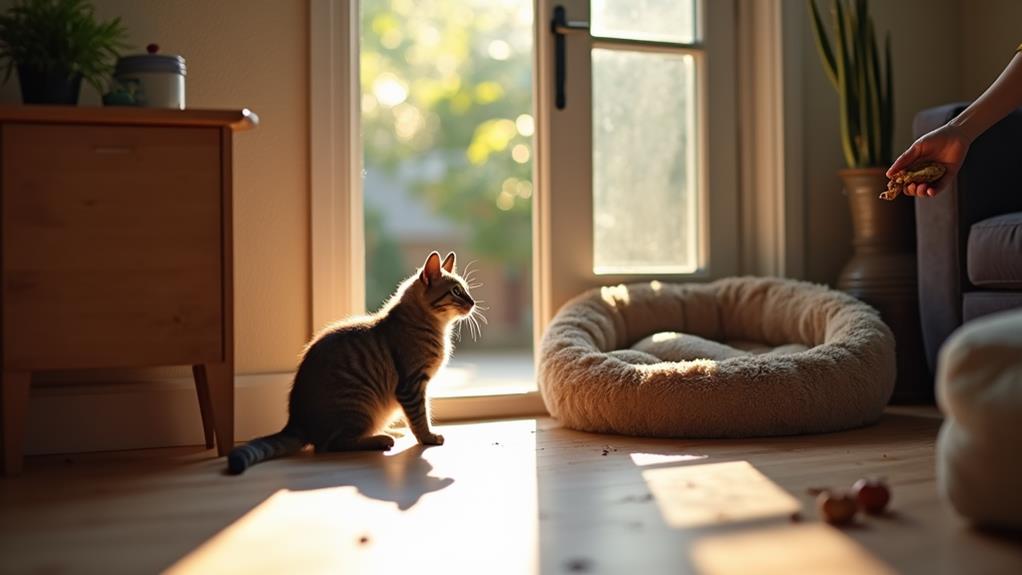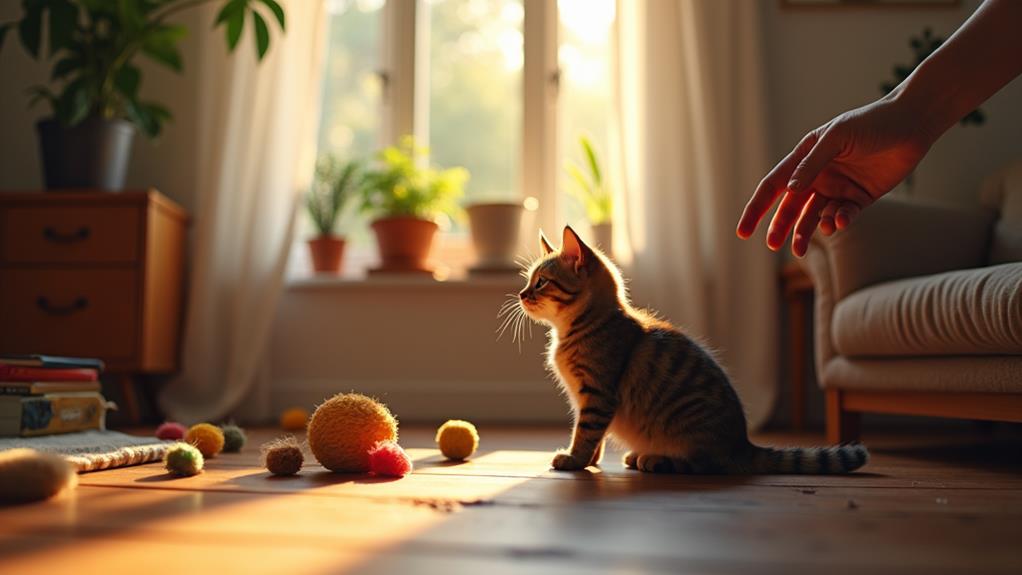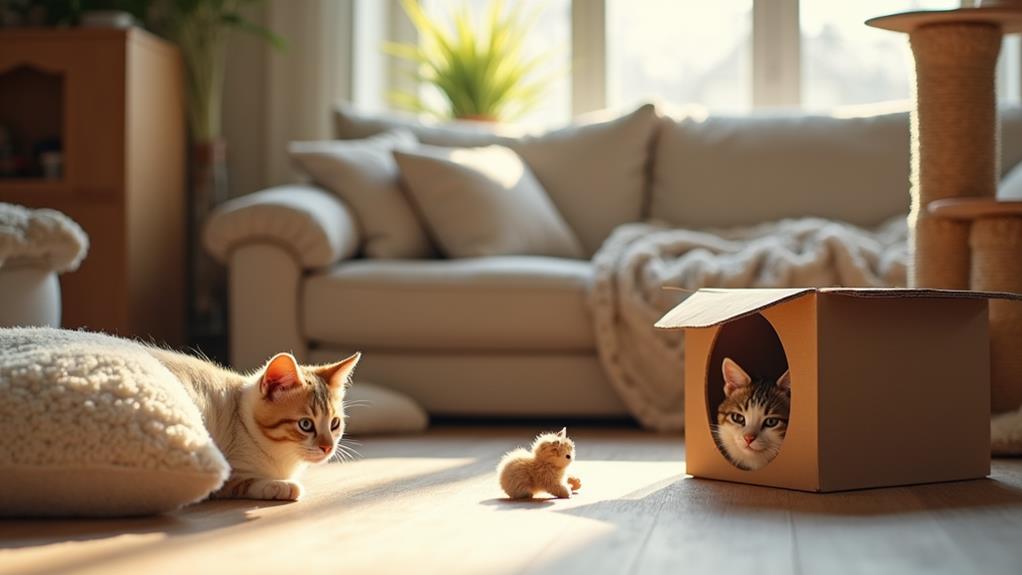How to Bring a Feral Cat Inside: Tips for a Smooth Transition

To bring a feral cat inside smoothly, create a safe space in a quiet room with necessities like separate food, water, and litter box areas. Add scratching posts, cozy hiding spots, and vertical spaces for comfort. Let the cat adjust gradually and expand access to your home as they become comfortable. Build trust by establishing a feeding routine and encouraging gentle interactions with treats. Use enrichment activities like puzzle feeders and interactive toys to engage their senses and encourage exploration. Consistent play fosters bonding and confidence. These steps will ease the shift, leading to more successful interactions.
Prepare a Safe Space
To successfully bring a feral cat inside, prepare a safe space that caters to its needs and fosters a sense of security. Start by dedicating a quiet room solely for the feral cat. This room should be free from busy areas and inaccessible to children and pets, ensuring minimal disturbances. Equip the space with vital amenities: place food and water in one corner and a litter box on the opposite side. This setup encourages exploration and reduces stress, helping the cat acclimate to its new environment.
Incorporate scratching posts and a variety of toys to provide stimulation and comfort. Vertical space is significant; install shelves or a cat tree to offer secure resting spots and climbing opportunities. This mimics the outdoor environment the cat is used to, making them feel more at home. Spend time daily in the room, engaging in calming activities like reading aloud. Your presence helps establish a sense of safety and trust. By creating this safe space, you're laying the foundation for a successful adjustment from the outdoors to indoor living, ensuring the feral cat feels comfortable and secure in its new home.
Allow Gradual Adjustment
When introducing a feral cat to an indoor environment, patience is key. Allowing the cat to adjust gradually helps reduce stress and fosters a sense of safety, making the shift smoother. Start by confining the cat in a quiet and secure space where it can investigate without feeling overwhelmed. This confined space serves as a sanctuary, allowing the cat to become accustomed to new sounds and scents without the pressure of immediate interactions.
- Imagine the joy of seeing a once-fearful cat ultimately relax.
- Feel the satisfaction of witnessing small steps toward trust.
- Experience the warmth of a bond formed through gentle patience.
As the cat becomes more comfortable, slowly expand its access to other areas of your home. Avoid forcing interactions with humans or other pets initially; let the cat investigate and engage when it feels ready. Spend time in the cat's space, perhaps reading aloud, to help it associate your presence with positive experiences. This can greatly aid in reducing stress and building confidence. Monitor the cat's behavior closely during this period; signs of relaxation or stress will guide the timing of further introductions. A thoughtful, gradual adjustment is crucial for a successful shift.
Build Trust With Interaction

Building trust with a feral cat, through consistent and gentle interaction, is essential for a successful change indoors. Begin by establishing a regular feeding schedule. This creates positive associations between you and the cat. Initially, allow the feral cat to eat without your presence. This helps build trust by letting the cat feel safe and unthreatened. Gradually increase your presence during feeding sessions, but avoid direct contact. This gradual increase helps the cat get used to your presence without feeling pressured.
To reinforce positive interactions, try using treats. A bit of gravy on your fingers can encourage the cat to approach and initiate contact. This method helps the cat associate your presence with positive experiences. When the cat becomes more comfortable, extend a closed fist towards it. Let the cat come closer on its own terms. Pay attention to the cat's body language; confirm it feels comfortable before attempting any physical contact.
Patience is key. Allow the cat to dictate the pace of interactions. Building trust might take time, especially with skittish adult feral cats. With time and patience, you'll facilitate a smooth change indoors.
Encourage Indoor Exploration
Bringing a feral cat indoors is just the beginning of its path to comfort and security. To promote indoor investigation, allow the cat to examine its new surroundings at its own pace. Create a welcoming space with plenty of hiding spots and vertical spaces, which can enhance its confidence. Start by giving access to a single, safe room, then gradually introduce new areas as the cat becomes more comfortable. This method builds trust and allows the cat to navigate without feeling overwhelmed.
Use treats and toys to entice the cat to venture beyond its initial safe zone, forming positive associations with different parts of the indoor environment. Observe the cat's body language closely during these explorations to guarantee it feels secure. Adjust the environment if any signs of stress or anxiety appear. Encourage interactive play sessions in diverse areas of your home, helping the cat to roam and uncover while strengthening your bond.
Remember, patience is key. Your presence and encouragement can transform a once-timid feline into a content member of your household.
- Witness the joy of a once-scared cat finding comfort
- Experience the bond of trust growing stronger each day
- See the transformation as fear turns into joyful exploration
Use Enrichment Activities

To help a feral cat adjust to indoor life, enrichment activities are vital. These activities not only engage their natural hunting instincts but also provide fundamental mental engagement. Start by introducing puzzle feeders. They're excellent for stimulating a cat's cognitive skills and mimic the act of hunting, reducing boredom and promoting a healthy weight. For interactive play, use toy balls filled with treats to encourage active play. This kind of physical activity is key for maintaining a healthy weight in indoor cats.
Incorporating scratching posts into your home is another significant step. Scratching posts allow the cat to mark its territory and maintain claw health, which reduces stress and helps the cat feel more comfortable in its new environment. Interactive toys, such as wand toys, are perfect for fostering bonding between you and your new feline friend. These toys satisfy the cat's natural desire to stalk and pounce, creating a stimulating environment.
Regularly rotate toys and introduce new enrichment activities to keep things fresh. This approach guarantees the environment remains engaging, helping your feral cat adapt seamlessly to the indoor life. Following these steps will make the change much easier.




